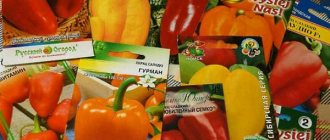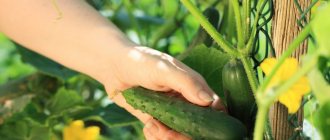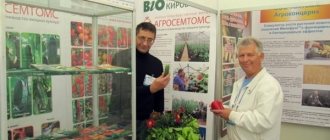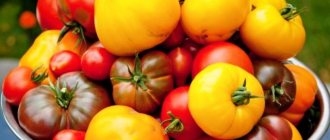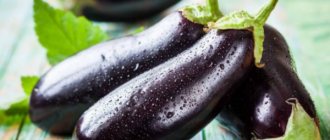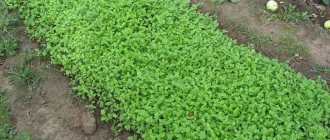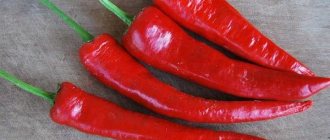Thick-walled peppers for greenhouses and open ground are increasingly popular among gardeners. Unlike thin-walled varieties, these varieties allow you to prepare a lot of different dishes: from sweet sauces and canned lecho to excellent fresh dishes. Choosing a thick-walled sweet pepper variety for planting in 2022 will be very difficult, since breeders’ catalogs are full of new products.
Of course, they are all worthy of close attention. However, for each farming zone it will be advantageous to use different varieties. In this article, we suggest finding out which early and mid-season varieties of thick-walled bell peppers for greenhouses and open ground should be chosen by summer residents living in Siberia and the Far East, the Urals and the Volga region, in central Russia and the Leningrad region, Volgograd and Moscow.
Look at the photo of some meaty varieties:
Fleshy bell pepper for greenhouses
Thick-walled peppers for greenhouses are distinguished by the thickness of the fruit wall (pericarp). Thick-walled varieties usually include all varieties whose wall thickness exceeds 6 mm. But currently varieties with a wall thickness of more than 10 mm are in demand. Such hybrids are intended for cultivation exclusively by seedlings. They require strict adherence to all rules of agricultural technology.
Fleshy varieties of sweet peppers are divided according to the shape of the fruit, their weight and color at the stage of technical and biological maturity. The most popular types are barrel-shaped, weighing more than 400 grams, with a small content of seeds inside. Yellow-fruited and white peppers are slightly inferior to them. Less often, summer residents risk planting varieties with purple fruit color. Although they look very elegant in various types of canned food and fresh in salads. Therefore, try to plant at least a few bushes with unusual colors.
The most interesting varieties of thick-walled sweet peppers for greenhouses are presented in the table below - there you can find out the main characteristics and read a brief description:
| Variety name | Fruit wall thickness | Short description |
| "Agapovsky" | 7 mm | Prism-shaped fruits, painted in a rich crimson color. The weight of one fruit is 250 - 300 g. The yield from a bush up to 80 cm high reaches 10 kg/m2. The first harvest can be obtained 3 months after emergence. |
| "Bogatyr" | 7 mm | It belongs to mid-season varieties, since the stage of technical maturity of the fruit occurs 4 months after emergence. The fruits are rich red in color, have a cone shape and weigh up to 180 g. Productivity is average – up to 10 kg/m2 |
| "Star of the East chocolate" F1 | 10 mm | The height of the bush is on average 70 cm. The yield reaches 8 kg with proper agricultural technology. The hybrid is an early hybrid and produces a massive harvest already 3 months after germination. The fruits are brown in color, cylindrical in shape and weigh 350 g. |
| "Cardinal F1 | 8 mm | Tall hybrid of early ripening. It takes 80 days from germination to technical maturity of the fruit. The shape of the fruit is cuboid, the color is unusual purple. The weight of one is up to 300 g. The yield per 1 m2 is 14 kg. |
| "California Miracle" | 8 mm | A variety that has been proven for decades, producing excellent yields in protected soil conditions. The fruits are cube-shaped with pronounced ribbing. Painted red. The weight of one pepper is 150 g. Productivity – 13 kg/m2. Ripening period is 4 – 5 months. |
| "Isabella F1" | 10 mm | The prism-shaped fruits of this hybrid are colored in dark shades of red. They weigh up to 170 g. They produce a harvest of up to 12 kg per 1 m2. It belongs to the mid-early varieties and requires an increased amount of potassium in the soil. The bushes are spreading with many fruits, but not tall - up to 60 cm. |
| "Indalo" F1 | 10 mm | The cube-shaped fruit weighs up to 200 g and is colored rich yellow. Productivity is up to 14 kg per 11 m2. The height of the plant reaches 2 meters. A mid-early variety, it yields the harvest at technical maturity 4 months after germination. |
| "Queen" | 12 mm | An early variety, the harvest of which can be harvested at technical maturity 80 days after emergence. The fruits are cube-shaped and colored red. The height of the plant reaches 75 cm. |
| "Claudio" F1 | 14 mm | A very productive early variety. In greenhouse conditions, it produces the first full-fledged harvests 70 days after germination. At the same time, up to 14 fruits of an elongated cuboid shape are formed on the bush. Resistant to most pepper diseases |
| "Orange Miracle" F1 | 8 mm | Indeterminate type with compact habit. In a greenhouse it will grow up to 2 meters in height. The fruits are cube-shaped, uniformly orange in color. They weigh up to 350 g. Productivity 12 kg/m2. Resistant to bronzing and tobacco mosaic virus. |
Super early varieties
We recommend reading our other articles
- Geranium flower
- Raspberry variety Golden Domes
- Onion variety Centurion
- Pear variety Marble
Super early varieties of thick-walled peppers are grown mainly for sale. Due to their short ripening period, they produce an early harvest, especially if they are grown in a greenhouse using the seedling method.
Super early varieties
- “Fat Baron” ripens in just 90 days. There is immunity to many diseases. The pepper is red, bright, with a glossy skin, cylindrical in shape, weight - 300-350 g on average, but there are also giants weighing up to 500 g. Wall thickness - 10 mm. Productivity per bush – 7 kg. The harvest is stored for a long time after harvesting and is suitable for transportation.
- "Zarya F1" matures in about 90 days. The fruits are cone-shaped and, when fully ripe, have a red color. Weight – 100-120 g, wall thickness – 8 mm. The pulp is juicy and aromatic. From a square of plantings you can harvest up to 8 kg of vegetables. The harvest is transportable, with excellent commercial qualities. After collection it is well stored. There is immunity to verticillium. Universal use.
- “Quickly F1” is an early variety for greenhouses and unprotected soil. Ripening occurs in 80-90 days. Pepper in the form of a cone, with a glossy red skin. Weight – 100-120 g. Wall size up to 7 mm. The taste is rich and sweet. Pepper is of commercial quality, suitable for long transportation. It has immunity to viruses and tolerates stressful growing conditions well. Productivity in a greenhouse is up to 9 kg per square, in open ground - no more than 5 kg/m. sq.
Pepper with thick walls for open ground
Peppers with thick walls for growing in open ground conditions must have certain characteristics. Cold resistance and the ability to successfully develop in conditions of low humidity and temperature changes during the day and night are important. But at the same time, street peppers are less affected by spider mites and practically do not suffer from viral mosaic and other dangerous diseases.
Thick-walled peppers for open ground are divided into Siberian and Kirov selections. Both species have all the necessary qualities to obtain large yields in risky farming areas. In the Kirov selection, it is worth paying attention to the new items in the 2022 catalogue. First of all, this is the “Desired” variety. It has a fetal wall up to 9 mm. When growing this variety of thick-walled peppers for open ground without film cover, the weight of one fruit is small - up to 140 grams. But on one plant more than 15 such fruits develop simultaneously. In general, the yield is 7-8 kg per 1 m2, which is quite good for unprotected soil. The fruits are trapezoidal, rich red in color.
Don’t ignore another variety of large pepper with thick walls from the Kirov selection - “Snegirek”. It is classified as early ripening, since it yields the crop at the stage of technical maturity 80 days from the moment the crop loops appear. It is not affected by blossom end rot and has a high degree of resistance to tobacco mosaic virus. It bears about 20–22 trapezoidal fruits on one bush up to 85 cm high. The weight of 1 fruit is 150 g. The wall thickness is 7 – 9 mm.
The fleshy bell pepper “Violet” is distinguished by the specific color of its fruit. The wall thickness is more than 1 cm. The weight of the fruit reaches 180 g. Productivity is high in open ground - about 11 kg per 1 m2.
In areas of risky farming, it is recommended to grow thick-walled sweet peppers for open ground “Flaming”. This is a hybrid resistant to adverse environmental factors. Features increased productivity. Its peculiarity is that it ripens directly on the vine in any weather conditions. Wall thickness 7 mm. Fruit weight – 140 g. Productivity – 8 kg per 1 m2
Other varieties of thick-walled sweet peppers for open ground can be seen in the table further on the page:
| Variety name | Wall thickness | Short description | |
| "Victoria" | 5-7 mm | It is classified as early ripening, it is possible to obtain a harvest at the stage of technical maturity 130 days after the appearance of mass shoots. The average height of the bush is 60 – 65 cm. The weight of the cone-shaped fruit reaches 80 grams. The overall yield is quite low - 3 kg per 1 m2. | |
| "The Dutch Giant" | 7-8 mm | An early variety that is resistant to frost, so it can be planted in early May under temporary film cover. Grows up to 70 cm. Form into 2 stems. Productivity up to 5 kg per 1 m2. The weight of the fruit reaches 250 g. It is thick-walled and cuboid-shaped. A mandatory tying of the bush to the support is required. Otherwise, the plant may break under the mass of fruits. | |
| "The Fat Baron" | 10 mm | Early, produces a harvest 90 days after germination. The bush is tall - up to 1 meter. Form into 2 stems. Be sure to provide reliable support. The weight of the prism-shaped fruit reaches 300 g. high yield - reaches 15 kg per 1 m2 with fairly good care. | |
| "Hercules" | 5-7 mm | A mid-early variety that produces a large number of sweet and aromatic fruits with thick walls. Intended both for fresh salad consumption and for all types of culinary processing, including canning and freezing. | |
| "King of the North" | 6-8 mm | Juicy fruits of golden sunny color with a pronounced aroma. Mid-early, gives a high yield in open ground with sufficient application of mineral and organic fertilizers to the soil. The weight of one fruit reaches 150 g. The bush will grow up to 80 cm in height. It is recommended to form 2 stems. Planting in open ground should be done after the seedlings reach the age of 70 days. | |
| "Baby Mammoth" | 9 mm | The compact habit of the bush, up to 80 cm high, produces a very rich harvest of large, aromatic, elongated fruits. In shape they resemble a mammoth tusk, which is why this name was given to the variety. The record length of the fruit is 30 cm. Weight is 250 g. Productivity per 1 m2 in unprotected soil conditions is 14 kg. | |
| "Admiral Kolchak" | 10 mm | Yellow glossy fruits with a rich yellow color have a cuboid shape. At the technical stage of maturity, they gain a weight of 300 grams. Productivity is up to 9 kg per 1 m2. It is classified as mid-season because it begins to produce a massive harvest 4 months after germination. | |
| "Sankina's Love" F1 | 8 mm | The bushes are low up to 70 cm). In open ground it is necessary to form 2 stems. Early, produces a full-fledged harvest at the stage of technical maturity 80 days after the emergence of shoot loops. The fruits ripen after picking within 7 – 10 days. Rich in ascorbic acid and have a very refined taste. The weight of the fruit is 16 grams. The total yield reaches 11 kg per 1 m2. | |
Benefits and harms
Bell pepper is an annual plant that belongs to the Solanaceae family. The shape can be very different - in the form of a ball, cone, cylinder or elongated. The weight of the fetus can reach 600 grams.
The vegetable contains the following vitamins, minerals and trace elements:
- vitamin A – 45 mcg;
- beta-carotene – 470 mcg;
- vitamin PP – 1100 mcg;
- vitamin C - up to 250,000 mcg, most of all in red varieties;
- vitamins B1 – 80 mcg, B2 – 60 mcg, B4 – 7750 mcg, B5 – 210 mcg, B6 – 520 mcg and B9 – 60 mcg;
- vitamin E – 500 mcg;
- vitamin K – 10 mcg;
- calcium – 15 mg;
- potassium – in yellow pepper – 205 mg, in green – 180 mg, in red – 170 mg;
- phosphorus – 30 mg;
- magnesium – 20 mg;
- sodium – 2.5 mg;
- iron – 1 mg;
- copper, selenium and zinc – up to 1 mg.
The product is low-calorie - up to 30 kcal per 100 grams.
Properties of the vegetable
Benefits of bell pepper:
- improves vision;
- strengthens the immune system;
- antioxidant;
- regulation of cholesterol levels;
- protects against stress;
- strengthens the nervous system and helps improve memory;
- slows down the aging of the body;
- restores bone tissue and regulates the rate of blood clotting;
- prevents the appearance of sclerosis;
- strengthens bones, hair, nails and teeth;
- regulates sugar levels;
- improves the functioning of the heart muscle;
- improves metabolism.
Different from others is red bell pepper, the benefits and harms of which are determined by a slightly different composition. The main element is the acid lycopene. It affects the immune system, strengthening it. Also, eating red pepper reduces the risk of metastases by 25%.
However, those who have chronic hypotension and coronary heart and vascular disease are highly discouraged from consuming pepper. This is due to the high content of capsacin, which lowers blood pressure and thins the blood. Also, you should not consume the product raw if you have diseases of the gastrointestinal tract, as it provokes increased secretion of gastric juice and digestive enzymes.
Thick-walled varieties for the Moscow region
The climatic conditions of this zone are unstable. Therefore, when choosing a variety of thick-walled sweet pepper for the Moscow region, you should first decide whether the crop will be grown in a greenhouse or open ground. For unprotected soil, it is worth choosing early and ultra-early species; mid-season ones are best left for film shelters.
Suitable thick-walled varieties of pepper for the Moscow region are: “Zlata Praga”, “Shchegol”, “Siberian Baron”, “Purple Bell”, “Yantar”, Kakadu” and many others. When choosing a variety, pay attention to its resistance to various diseases. In the Moscow region, this crop is often affected by blossom end rot. Therefore, it is advisable to purchase hybrids with genetic resistance to this disease.
Growing giant peppers
Some gardeners get large fruits from the most common pepper varieties.
And sometimes, the seeds of the largest-fruited varieties are not pleasing with the results. What needs to be done to be guaranteed to get giant fruits? The main requirements will be:
- Choosing the right variety. This includes the need to take into account climatic conditions. Pepper loves heat, so in regions with a cool climate it is better to grow large fruits in greenhouses or under film covers. This also applies to lighting. Pepper varieties for open ground are more hardy and resistant. There are species that feel great when planted in any type of soil. Based on this, carefully study the advice of experts on growing a certain type of large pepper. Modern breeders every year offer new names of large-fruited peppers that can produce high yields with normal care.
- Competent implementation of agrotechnical recommendations. Peppers love watering. It is enough to flood the beds well once a week so as to wet the soil to 60 cm. During dry winds, add refreshing watering and be sure to loosen the soil the next day. Then mulch the holes with straw and try to maintain the feeding schedule. You also need to take into account that large-fruited hybrids are very demanding on the watering schedule. If varietal large peppers tolerate irregularity, then you need to be more careful with hybrids. Otherwise, the peppers will be large, but there will be very few of them on the bush.
If you follow the rules, you can be sure that the pepper will reach its maximum size. Some names are distinguished by the weight of peppers up to 850 g. Although fruits over 180 g are considered large, some lovers strive to get huge peppers. To do this, it’s worth taking a closer look at the representatives of large-fruited peppers.
Varieties for central Russia
Thick-walled peppers for central Russia are selected according to the characteristics indicated above. It must meet the following requirements:
- resistance to temperature changes;
- quick return of mass harvest at the stage of technical maturity;
- relative resistance to tobacco mosaic virus, bronzing, blossom end rot and spider mites;
- high yield.
Low-growing varieties in the middle zone can be grown in open ground. But they require installation of supports.
The best varieties are: “Marshal Zhukov”, “Zorka”, “Montero”, “Sanka’s Love”, “Anastasia”, “Tusk”, “Butus”, “Emelya”, “Father Frost”, etc.
Reviews from the forum
— When growing without film, I used Pioneer pepper. I received fruits very early, which ripened quickly, despite temperature changes. I also liked “Swallow” and “Atlant”, they are resistant to temperature changes and diseases.
— I would especially like to note such varieties of pepper as “Nadia” and “Bullfinch”. Fruit formation began early. The varieties justified all the efforts to grow seedlings and create a warm bed. The harvest was enough for both canning and fresh eating.
Thick-walled varieties for the Urals and Siberia
Please note that the climate zones of the Urals and Siberia may differ significantly from each other. There is the Polar Urals, where permafrost prevails and it is, in principle, very difficult to grow anything in open ground, and the Southern Urals. Many crops can be successfully cultivated there without shelter. The situation is similar with Siberia.
There is a special Ural and Siberian selection of pepper seeds with thick walls. It is best to choose thick-walled pepper varieties for Siberia and the Urals from the so-called zoned selection collections - they contain many new products for 2022. Pay attention to the offers of local agrotechnical stations. They test the resistance of varieties to unfavorable conditions characteristic of a particular zone.
Thick-walled varieties of peppers for the Urals are: “Victoria”, “Flamenco”, “King of the North”, “Giant Dutch”, “Belozerka”, “Mercedes”, “Alexiy”, “Zdorovye” and many others.
Yellow cube F1
Forms a powerful bush, the height of which is up to 100 cm. The fruits are richly bright in color and weigh from 250-300 g.
The hybrid is resistant to the tobacco mosaic pathogen. When stored, pepper fruits retain their taste for a long time.
Among the mid-season varieties there are also bright representatives. Their ripening period ranges from 100-120 days.
The subtleties of growing thick-walled peppers
In general, you can read about the agricultural technology of bell peppers in a special article on our website. But there are certain subtleties in cultivating thick-walled varieties.
The first thing thick-walled peppers need is a neutral soil reaction. With a high degree of acidity, this culture will not grow and develop. Remember the rule. For 1 m2 of soil intended for growing this crop, 5 kg of dolomite flour is required.
The second important condition is the addition of a large amount of potassium at the stage of preparing the soil for planting seedlings. Do not apply ammonium nitrate - it will stimulate the growth of large foliage and delay the process of fruit set.
The third trick is that 2 weeks after planting the seedlings in a permanent place of growth, you must begin regularly spraying with a solution of boric acid. 1 g per 1 liter of water. Spray the entire bush with abundant wetting of the foliage every other day. This will stimulate the formation of a large number of fruits.
After the fruits have set, you need to start applying regular fertilizing. Typically the procedure looks like this. 5 liters of water are poured onto 1 bush. Then mineral or organic liquid fertilizer is applied and 5 liters of water are poured out again. Then the soil is loosened and a 5 cm layer of mulch is laid on top of it.
Features of cultivation and care
If you don't have a greenhouse, pepper seeds should be sown in February so the plants are 90-100 days old before transplanting in May. Pepper does not tolerate transplantation, so try to immediately sow the seeds in separate peat pots with a diameter of about 8-10 cm. Using large pots does not make sense due to the slow development of its root system.
The substrate for growing pepper in seedlings should be light and loose and consist of 2 parts humus mixed with 1 part sand and 1 part soil. For 1 kg of this mixture, add a tablespoon of ash.
Do you find it necessary to add ash to the soil mixture?
Not really
Pepper seeds require pre-planting treatment:
- They must be stored until they swell for five hours in water at a temperature of about + 50 ° C.
- After this, they must be placed for germination in wet gauze for 2-3 days, the room temperature is about +20 ° C.
- By carrying out such a simple preliminary sowing process, you will get seedlings literally the next day after sowing.
Sown pepper seeds should be thoroughly watered and immediately covered with plastic film or glass. Before the sprouts appear, they can be in any warm place (about + 22 ° C), lighting does not matter, perhaps in the dark. After the shoots appear, the optimal temperature for growing seedlings during the day is about +26-28 ° C, at night about +10-115 ° C.
Pepper seedlings
Do not pamper the pepper with excessive watering, this can only cause harm and cause blackleg disease. But try not to let the substrate dry out. Water for irrigation should be warm - about + 30 ° C; if it is too cold, the seedlings will get sick and die. Do not forget to monitor the air in the room in which the seedlings are grown; it should not be too dry.
Pepper seedlings require additional lighting. During February it should be lit from 7am to 9pm. Before planting, seedlings need to be hardened, gradually accustomed to the rays of the sun, lower temperatures, wind and rain. To do this, the plant is taken out into the fresh air, gradually increasing the time it stays there. During hardening, monitor weather conditions; you should not allow the pepper to be exposed to frost. The optimal temperature is not lower than + 13 ° C.
Planting pepper
The best predecessors of peppers: onions, cucumbers, pumpkin, cabbage, zucchini and carrots. Bad predecessors: potatoes, peppers, tomatoes, physalis and eggplants.
Light soils are best suited for growing:
- It is better to prepare the soil for peppers in advance throughout the year, adding 5 kg of organic fertilizers per 1 m2, and in the fall 50 g of potassium and phosphorus fertilizers for deep digging.
- In the spring, 40 g of ammonium nitrate is added to the top layer of soil on the site.
- Five days before transplanting pepper seedlings to a permanent place, disinfect the soil using a solution - add a tablespoon of copper sulfate to a bucket of water.
Plants are planted in an open area at the end of May - mid-June, according to a 40x40 cm pattern. Pepper seedlings are planted in unheated film greenhouses in early April, and in tunnel shelters at the end of May.
Place the seedlings in the holes at the same depth at which the plants grew in the seedling box, without exposing the roots and without digging in the root neck. Pepper does not like cold soil, and if you want to get a serious harvest, arrange high beds for it, which need to be raised by 25-55 centimeters.
Expert opinion
Filatov Ivan Yurievich, private farmer for more than 30 years
Remember that peppers are very susceptible to dust, so if you plant several varieties in your garden, try to space them as far apart as possible and, if possible, separate them by planting tall tomatoes, corn and sunflowers.
Growing pepper seeds in open ground is inappropriate even in the southern regions. Sowing will still be late, when the soil warms up, the plant will develop more slowly, the first fruits will ripen later, and the fruiting period of the pepper will be much shorter.
Is it possible to take seeds from store-bought peppers?
A very common question from summer residents is whether it is possible to take seeds from store-bought peppers to grow on their property. Indeed, in winter, excellent thick-walled, fleshy bell peppers are sold in stores. They have good taste and can be stored for a long time without processing. Overall, excellent properties. But is it possible to grow a full-fledged crop from seeds obtained from such fruits?
Yes, you can. I have conducted such experiments many times. I can secretly say that every year more than 20 pepper bushes grow on my plot, grown from just such seeds. Their productivity is above average. They retain all the properties of store-bought fruits. Unfortunately, I have no experience in growing from seeds already collected from these plants.
So, experiment. Good luck to you in the new season.
The best peppers for stuffing and processing
The most suitable varieties for stuffing are those with medium-sized fruit and an even shape. These include:
- Lyubava.
- Miracle.
- Bogdan is yellow-fruited.
- Golden miracle.
- Red miracle.
- Marinkin Tongue.
- Lyudmila.
- Lemon miracle.
- New Russian.
However, the most popular is the Triton pepper. Triton pepper - description: weight up to approximately 200 g, red-colored, cone-shaped, fertility reaches 4 kg.
Golden Taurus
Golden calf is suitable for open ground and for growing in greenhouses. The glossy fruits weigh on average about 250 g.
The ripening process is accompanied by a change in color. Loves feeding and watering. When planting seedlings in the ground, it is recommended to maintain a certain density: per 1 sq. m 5 plants.
To improve fruit set, biostimulants are used.
Sweet pepper is a low-calorie product. 100 g contains only about 25 kcal.

